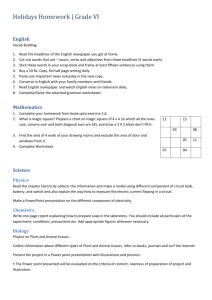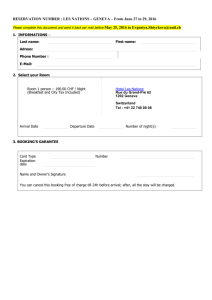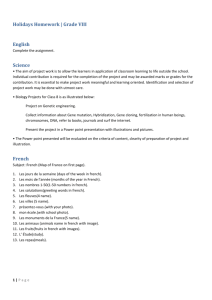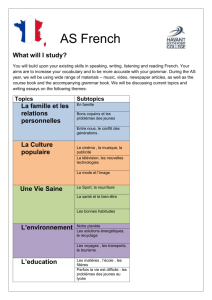14 & 15
advertisement
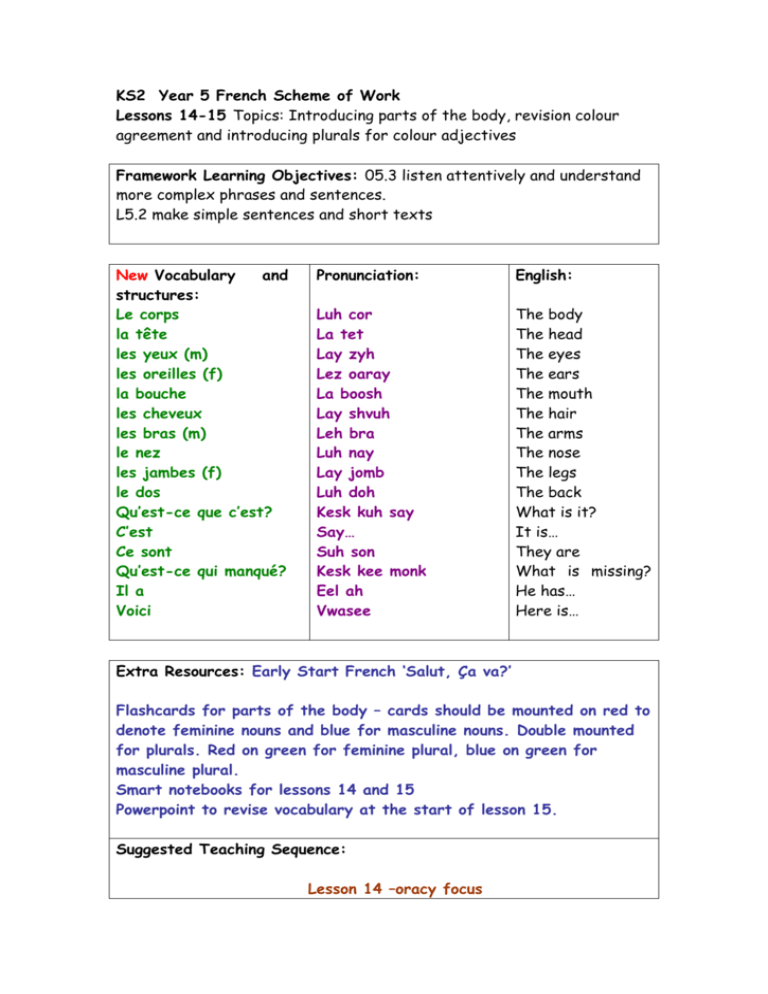
KS2 Year 5 French Scheme of Work Lessons 14-15 Topics: Introducing parts of the body, revision colour agreement and introducing plurals for colour adjectives Framework Learning Objectives: 05.3 listen attentively and understand more complex phrases and sentences. L5.2 make simple sentences and short texts New Vocabulary and structures: Le corps la tête les yeux (m) les oreilles (f) la bouche les cheveux les bras (m) le nez les jambes (f) le dos Qu’est-ce que c’est? C’est Ce sont Qu’est-ce qui manqué? Il a Voici Pronunciation: English: Luh cor La tet Lay zyh Lez oaray La boosh Lay shvuh Leh bra Luh nay Lay jomb Luh doh Kesk kuh say Say… Suh son Kesk kee monk Eel ah Vwasee The body The head The eyes The ears The mouth The hair The arms The nose The legs The back What is it? It is… They are What is missing? He has… Here is… Extra Resources: Early Start French ‘Salut, Ça va?’ Flashcards for parts of the body – cards should be mounted on red to denote feminine nouns and blue for masculine nouns. Double mounted for plurals. Red on green for feminine plural, blue on green for masculine plural. Smart notebooks for lessons 14 and 15 Powerpoint to revise vocabulary at the start of lesson 15. Suggested Teaching Sequence: Lesson 14 –oracy focus If schools have been following the Camden Years 3 and 4 schemes, body parts will be a brand new topic. Using the Smart notebook for lesson 14, slide 1, share learning objective with the class Using slide 3, introduce the term ‘le corps’ meaning the body. Using either the smart notebook slides 4-12 or flash cards to present the parts of the body using mimes (point to each appropriate body part). Run through repetition of all words and mimes again using different volumes and tones of voice. Look out for children remembering generic rules such as silent ‘s’ at the end of many words. Draw children’s attention to ‘le, la, les’. What do they mean? (the) Why are they colour coded red, blue and green? (fem, masc, plural) How are they different from ‘un, une’? (the = definite article and a = indefinite article). N.B. children will have met the definite article before in the Year 4 scheme of work when learning about places around town and school and when learning about hobbies and lessons. With all the body parts on display (either flash cards or slide 13 of the smart notebook) Teacher does a mime for one of the parts of the body and asks the question “Qu’est-ce que c’est?” (What is it?) Class calls out “C’est…” (It is…) followed by the name of the corresponding part of the body or “Ce sont” (They are…) for plural body parts. In pairs, pupils take it in turns to replicate this activity: one of the pupils does a mime for one of the parts of the body and their partner states which part of the body it represents. N.B. if children are struggling with c’est/ce sont praise correct naming of body parts. Using slide 14, sing a song using the new vocabulary and tune of Head, Shoulders, Knees and Toes by simply using the part of the body vocabulary in the order it appears below: la tête les yeux les oreilles et la bouche les cheveux les bras les jambes le dos et le nez Using slide 13 or all the flash cards on display, do the sequence of mimes for the parts of the body in the order in which they appear on the board and miss one out before asking the key question. Class identifies the missing mime/part of the body. Pupils replicate this activity in pairs. Using slide 15, consolidate whole class learning by playing “Jacques a dit” (Simon says). When the teacher says “Jacques a dit + part of the body, class repeat and point/touch the part of the body said. e.g 1. Touchez les cheveux 2. Touchez les jambes 3. Touchez le dos 4. Touchez la tête 5. Touchez la bouche 6. Touchez les yeux 7. Touchez les bras 8. Touchez les oreilles Pupils replicate this activity in pairs. Using slides 16, 17 revise colour agreements covered in Year 5, lessons 9-10 and 11-12. Using slide 18, revise numbers to 12. Using slide 19, introduce the final task. Working in pairs, pupils describe a monster to each other that they have imagined with different numbers of the relevant body parts in different colours. For example, they might describe a monster with three green heads, four yellow eyes, six blue legs etc. ‘Their partner has to demonstrate their understanding by using coloured pencils to draw what they hear. The phrase ‘Il a’ (It has) is a useful sentence starter. Remind them that colour adjectives come after the noun. e.g. ‘Il a trois têtes vertes’ (He has three green heads.) Slide 20 has all the relevant vocabulary in the correct order for sentence building. The ‘s’ are in brackets as they are only needed if describing plural body parts. They are not heard as ‘s’ on the end of French words is generally silent. Also point out that when they give the exact number of body parts they no longer need to use le/la/les (the). e.g. Il a deux bouches rouges. Plenary: Pupils show and describe their monsters to the class using the known vocabulary “Il/Elle a….” plus the body parts and colours. Lesson 15 – literacy focus Revise body parts using the PowerPoint for lesson 15 (slides 110). In order to focus on literacy skills, use the PowerPoint (slides 11-16) to play ‘Qu’est-ce qui manque?’ (What’s missing?). Children look carefully at Mr Men and decide which body part is missing. Look at flash cards on display in classroom and quickly write down missing body part on mini whiteboard. Check spelling when answer flashes up and discuss any new or familiar phonics. Play Chinese Whispers in groups of 6. Give child 1 a body part written down and ask them to relay the word letter by letter. Child 6 should write the word on their mini white board. For a competitive element you could see which group finishes first. Using the Smart notebook for lesson 15, split the tables/groups of six children into two groups of 3. Give one child a blue crayon/white board pen, another red and the third green. Using slide 2, use the reveal tool to display body vocabulary one by one. They are missing their articles (le, la, les). As you name the revealed body part, the children have to decide who will write it down based on whether it’s feminine or masculine or plural word (the child with the red crayon will write down all the feminine words, the child with the blue all the masculine and the child with green all the plurals). They should add le/la/les at the start as appropriate (the child with blue writing ‘le’ as it is masculine, the child with red writing ‘la’ as it is feminine and the child with green writing ‘les’ as it is plural). Children swap boards/paper with the other three children on their table and mark answers at the end. Reveal correct articles to help them mark each other’s work. (Hidden under the orange ‘Were you correct box’). Next, using slide 3, focus on the plural body parts. See if the children can remember whether they were they feminine or masculine plurals? Why is it important to know before we start writing? (need for colour adjectives to agree e.g. ‘les jambes’ is feminine plural so if you want to describe them as green you will need to say ‘les jambes vertes’ choosing the feminine plural version of the colour adjective green). In the plural most colour adjectives add an ‘s’ (except orange and brown as they are also nouns – orange and chesnut). The plural ‘s’ is silent and does not affect the pronunciation (see slide 4). Using slide 5, return to last week’s oral activity. Model drawing a monster and describing it but this time add a written description underneath. Use opening phrase ‘voici’ (here is). Draw attention to adjective/noun agreement. Independent work: Children create a monster and describe it in writing. They must refer to written support e.g. colour flash cards, number flash cards, body parts flash cards or use the worksheet provided and a print off of slide 20 from the smart notebook to accompany lesson 14. Higher attainers could use a French dictionary to look up alternative colours and body parts or even some new adjectives to describe the monster! Lower attainers should focus on knowing whether the body part is masculine or feminine and making the colour adjective agree. Plenary: share work and celebrate. Follow-up and consolidation At every opportunity new vocabulary should be practised. Once nouns have been introduced, you could call them out as brain gym activities. You could also use the body parts in the hall during a PE warm up, with the verb touchez or adding in some new command verbs*. Pupils could answer the register by naming and pointing to a body part if your flash cards are left up on display. *Remember, that regular verbs ending in “er” would need to end in “ez” to become instructions used to the whole class. This spelling change does not, however, change the sound. http://www.tout-le-monde.co.uk/ Has a fun song that revises body parts and will give you some new commands (not that it also includes weather and temperature) Sample resources> Continue> Pupil> Level 1> Module 2> Chanson The dictionary will help you translate any unknown vocabulary and give you plural versions of all the commands. The other activities in module 2 relate to body parts as well. Ed Emberly, Va-t’en, Grand Monstre Vert! is a lovely French story that describes a horrible monster!
